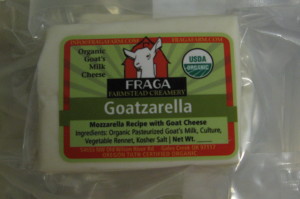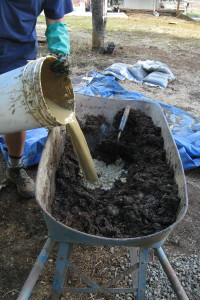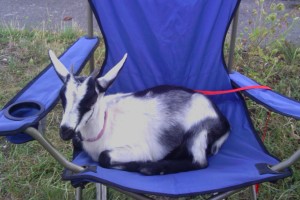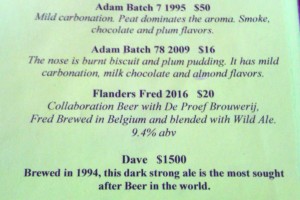My twenty-seventh farm was Fraga Farmstead Creamery in Gales Creek, Oregon.
The Farm
The farmers are Elisabeth and Steve. Lise emigrated from Germany and Steve is from Santa Cruz, California. They bought Fraga Farm from the original family owners in 2012. The property came with a herd of goats and an established organic cheese dairy. Steve built a new dairy following floor plans designed by Gianaclis Caldwell, the guru of cheese making and goat dairies from Pholia Farm. While the new dairy was being built, they commuted from Sweet Home two hours away. In March 2015 Lise and Steve finally moved on to their new farm. Lise milks the handsome Alpine goats, and Steve, who made cheese as a hobby, is now a professional cheesemaker.
My Experience
“You can’t park here!” was my welcome as I pulled up to Fraga Farmstead Creamery. I couldn’t complain about Lise’s gruffness, she had offered to host me on short notice. My previous farm, The Mushroomery, hadn’t worked out and I wanted to WWOOF for another two weeks before going home to Seattle.
At Fraga, WWOOFers get to choose what they want to focus on. I chose cheese making because I’m interested in the fermentation and eating of hard cheeses. Not many goat dairies make hard cheeses so I was excited by this opportunity. About every other day, I worked with Steve in his bright white, high-ceiling new dairy. Steve is meticulous about sanitation. Only indoor clothes can be worn in the dairy. When Steve took the whey to the pigs, he changed into his outdoor clothes to walk to the pig pen, then changed back into his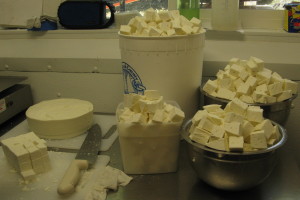 indoor clothes to return inside the dairy. I soon found out he didn’t like cameras or coffee cups in the dairy either. Cheesemaking follows the same basic formula in every dairy: Milk is heated to kill off bacteria (pasteurizing); a few drops of rennet are added to separate the thick curds from the liquid whey; a culture starts the fermentation and gives the cheese a particular style and flavor; the curds are hung in cheesecloth to drain off the whey; finally, salt and seasoning are added and the curds are pressed into molds to remove the remaining whey and firm up. Hard cheeses are placed in a temperature controlled room or cellar to age. Soft cheeses are aged two weeks to two months. Fresh cheeses are ready to eat after a few days. Steve found used commercial equipment from other industries that worked perfectly for making cheese. He made small batches of cheese in a soup making vat. Both soup and milk need to be heated in a controlled way. For seasoning his soft cheeses, he had Tillamook ice cream buckets. We even used ice cream scoops to scoop out the cheese into containers for sale. When I ask cheesemakers who use goat’s milk what kind of cheese they make, they always reply ‘chevre.’ As Steve reminded me, chevre means goat in French. While technically chevre is any cheese made from goat’s milk, the word in the US typically denotes a soft cheese rather like cream cheese. Besides the chevre, I tried the raw milk feta that is aged in brine for several months and the Goatzarella which melts in a gooey way as the name suggests. My favorite was the Rio Santiam, a raw milk hard cheese that is aged for several months. It is similar to parmesan but has more complex flavors. I also liked Steve’s innovation with Drunken Billy, a hard cheese bathed in wine. It was the perfect use of Trader Joe’s Two Buck Chuc
indoor clothes to return inside the dairy. I soon found out he didn’t like cameras or coffee cups in the dairy either. Cheesemaking follows the same basic formula in every dairy: Milk is heated to kill off bacteria (pasteurizing); a few drops of rennet are added to separate the thick curds from the liquid whey; a culture starts the fermentation and gives the cheese a particular style and flavor; the curds are hung in cheesecloth to drain off the whey; finally, salt and seasoning are added and the curds are pressed into molds to remove the remaining whey and firm up. Hard cheeses are placed in a temperature controlled room or cellar to age. Soft cheeses are aged two weeks to two months. Fresh cheeses are ready to eat after a few days. Steve found used commercial equipment from other industries that worked perfectly for making cheese. He made small batches of cheese in a soup making vat. Both soup and milk need to be heated in a controlled way. For seasoning his soft cheeses, he had Tillamook ice cream buckets. We even used ice cream scoops to scoop out the cheese into containers for sale. When I ask cheesemakers who use goat’s milk what kind of cheese they make, they always reply ‘chevre.’ As Steve reminded me, chevre means goat in French. While technically chevre is any cheese made from goat’s milk, the word in the US typically denotes a soft cheese rather like cream cheese. Besides the chevre, I tried the raw milk feta that is aged in brine for several months and the Goatzarella which melts in a gooey way as the name suggests. My favorite was the Rio Santiam, a raw milk hard cheese that is aged for several months. It is similar to parmesan but has more complex flavors. I also liked Steve’s innovation with Drunken Billy, a hard cheese bathed in wine. It was the perfect use of Trader Joe’s Two Buck Chuc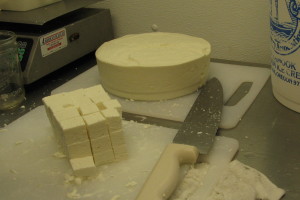 k organic wine. Steve’s cheeses were some of my favorites from the goat dairies I’ve WWOOFed on. I was impressed by their flavor; each was quite different from the others. Steve liked repeating Gianaclis’s quote “Cheese making is 95 percent washing and cleaning.” When Steve was done with the cheese making tasks for the day, it was my turn to wash buckets and clean up.
k organic wine. Steve’s cheeses were some of my favorites from the goat dairies I’ve WWOOFed on. I was impressed by their flavor; each was quite different from the others. Steve liked repeating Gianaclis’s quote “Cheese making is 95 percent washing and cleaning.” When Steve was done with the cheese making tasks for the day, it was my turn to wash buckets and clean up.
Fraga is one of the few farms I’ve been on that is focused on eventually making a profit. Steve says to be financially sustainable, the farm needs to grow. The plan is to double the herd size, hire more employees, and make cheese every day. Speed and efficiency is also important. They have a nice milking set up. Eight goats are milked at once by only one person. The milk is pumped into a holding vat; there are no milk buckets to lug and pour into storage vessels. They already have a famous customer: Amy’s restaurant is based in Oregon, and uses their organic cheeses in the restaurant and in their packaged pizzas. On the weekends they sell at five farmers markets which gives them the opportunity to meet chefs and other potential big customers. Steve mentioned that he is worried that a soon-to-be dairy with 7,000 goats in Wisconsin will lower prices and demand for his cheeses. The quality and innovation of Steve’s cheeses should set him apart from a large commercial dairy.
A cob pizza oven was being built next to the pen of baby goats. Another WWOOFer named Alex had been given a  copy of Build Your Own Earth Oven by Kiko Denzer and told to go out and make a pizza oven. The book had step-by-step directions, but building the oven didn’t go that easily. Alex had spent a couple of weeks getting it to the point where it just needed the outside insulation of cob. To make the cob, Alex made a slurry of clay and water in a bucket. He shoveled wood chips into a wheelbarrow, and poured the slurry into the woodchips, stirring by hand. We grabbed a handful of the cob, squeezed it into a solid ball and placed it firmly on the sandy, brick base of the oven. There was an art to getting the right thickness and shape; we’d step back to check our work and look at what the other had done. Unfortunately, the cob needed to dry for at least two weeks before the oven could be used. I would be gone by then.
copy of Build Your Own Earth Oven by Kiko Denzer and told to go out and make a pizza oven. The book had step-by-step directions, but building the oven didn’t go that easily. Alex had spent a couple of weeks getting it to the point where it just needed the outside insulation of cob. To make the cob, Alex made a slurry of clay and water in a bucket. He shoveled wood chips into a wheelbarrow, and poured the slurry into the woodchips, stirring by hand. We grabbed a handful of the cob, squeezed it into a solid ball and placed it firmly on the sandy, brick base of the oven. There was an art to getting the right thickness and shape; we’d step back to check our work and look at what the other had done. Unfortunately, the cob needed to dry for at least two weeks before the oven could be used. I would be gone by then.
How best to advertise goat cheese at a farmer’s market? Bring a baby goat! One sunny afternoon, I accompanied Lise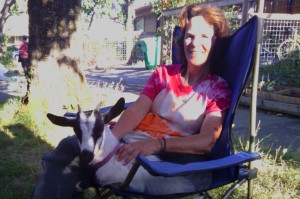 and Duchess to a Portland farmers market. Duchess was to sit on my lap. Lise gave me a pee-pad for my lap in case of an accident. “Goats don’t pee or poop when they’re sitting down so you’ll be okay. Just be sure to get her into the grass quickly when we get there since she’ll want to pee,” Lise advised me. Duchess was a good passenger and the drive went smoothly. At the market, Duchess sat in her lounge chair throne as admirers came by to pay their respects. All the admiration tired her out. She slept curled up like a cat on the way home. By the time we arrived at the farm, Duchess had woken up. Lise got out of the car and Duchess walked over to the driver’s seat while I untangled myself to get out. Now standing, Duchess peed down the gap between the driver’s seat and the cup holder. Unfazed, Lise commented the following day that the smell only lasted an hour while she was driving.
and Duchess to a Portland farmers market. Duchess was to sit on my lap. Lise gave me a pee-pad for my lap in case of an accident. “Goats don’t pee or poop when they’re sitting down so you’ll be okay. Just be sure to get her into the grass quickly when we get there since she’ll want to pee,” Lise advised me. Duchess was a good passenger and the drive went smoothly. At the market, Duchess sat in her lounge chair throne as admirers came by to pay their respects. All the admiration tired her out. She slept curled up like a cat on the way home. By the time we arrived at the farm, Duchess had woken up. Lise got out of the car and Duchess walked over to the driver’s seat while I untangled myself to get out. Now standing, Duchess peed down the gap between the driver’s seat and the cup holder. Unfazed, Lise commented the following day that the smell only lasted an hour while she was driving.
A nice perk at Fraga, is getting to stay in Lise’s house in northern Portland during the weekend. I started my weekend by driving to the coast and hiking the Cape Lookout trail through the forest to a cliffside overlook of the Pacific 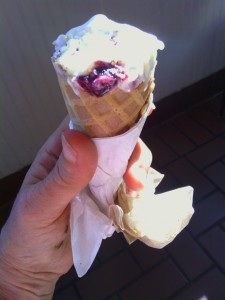 Ocean. Being near Tillamook, I had to visit the Tillamook cheese factory. I noticed the longest line was for ice cream. It was around 90 degrees out. After sampling the cheeses, I let the masses influence me and got in line for ice cream. I think of Tillamook for cheese, not ice cream, though Steve’s buckets reminded me of it. The menu of flavors was long. How to choose? While I wasn’t blown away by the cheese samples, I was impressed by the ice cream. (I started buying half-gallon containers of it when I got back to Seattle.) In Portland, I visited breweries. For dinner after the ice cream, I went to Hair of the Dog. Some of their beers are named after their brewers. The menu listed a vintage bottle of Dave for $1,500. Their beers do age well. On the past New Year’s Eve, I opened a ten-year-old bottle of Doggie Claws barleywine I’d been storing. The flavors were malty, full, and complex. It was the best beer I’d ever had. I told this to my waiter who didn’t appear to care. While I have a lot of respect for Hair of the Dog, I preferred the beer, food, and ambiance at the other two breweries I visited. The pizza and hoppy beer at Hopworks Urban Brewing were great, and I enjoyed watching a Seahawk game while sampling sour beers and eating a sandwich at Breakside Brewing. I had a pleasant digestion while walking the forested trails of Forest Park to Pittock Mansion. This was my first experience seeing Portland beyond the I-5 traffic. It did seem like Portlandia with pleasant leafy neighborhoods where people stroll around barefoot.
Ocean. Being near Tillamook, I had to visit the Tillamook cheese factory. I noticed the longest line was for ice cream. It was around 90 degrees out. After sampling the cheeses, I let the masses influence me and got in line for ice cream. I think of Tillamook for cheese, not ice cream, though Steve’s buckets reminded me of it. The menu of flavors was long. How to choose? While I wasn’t blown away by the cheese samples, I was impressed by the ice cream. (I started buying half-gallon containers of it when I got back to Seattle.) In Portland, I visited breweries. For dinner after the ice cream, I went to Hair of the Dog. Some of their beers are named after their brewers. The menu listed a vintage bottle of Dave for $1,500. Their beers do age well. On the past New Year’s Eve, I opened a ten-year-old bottle of Doggie Claws barleywine I’d been storing. The flavors were malty, full, and complex. It was the best beer I’d ever had. I told this to my waiter who didn’t appear to care. While I have a lot of respect for Hair of the Dog, I preferred the beer, food, and ambiance at the other two breweries I visited. The pizza and hoppy beer at Hopworks Urban Brewing were great, and I enjoyed watching a Seahawk game while sampling sour beers and eating a sandwich at Breakside Brewing. I had a pleasant digestion while walking the forested trails of Forest Park to Pittock Mansion. This was my first experience seeing Portland beyond the I-5 traffic. It did seem like Portlandia with pleasant leafy neighborhoods where people stroll around barefoot.
While I had an overall good experience at Fraga Farmstead, I didn’t feel very productive or needed. I got homesick being so close to Seattle, and the signs on I-5 pointing to Seattle in Portland didn’t help. I decided to leave a few days early to spend more time with my dad before he flew back to Tucson at the end of the summer.

